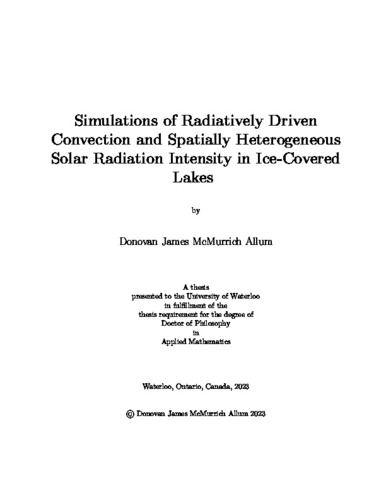| dc.description.abstract | At the end of winter as sunlight and increasing air temperatures melt the snow layer above the ice, allowing significant radiation from the sun to enter the water column. In the cold water regime (T < 4 °C, where 4 °C is the freshwater temperature of maximum density) increasing the temperature also increases the density, contrary to warm water settings. Therefore, adding heat near the surface results in radiatively driven convection. This process under ice has received a lot of attention recently from fluid dynamicists and limnologists in part due to its uniqueness (solar radiation driving convection, shielding from wind), and its sensitivity to global warming due to its very narrow temperature range. Previous simulations have mostly focused on two dimensions (2D) and ignored spatial heterogeneity of the solar radiation intensity. In this thesis, I use direct numerical simulations to compare radiatively driven convection in two and three dimensions - with and without a background stratification - and the impact of spatially varying solar radiation intensity in cold water in both two and three dimensions (3D). The simulations presented here are in idealized and simplified systems to isolate the dynamics of interest.
The findings in Chapter 3 demonstrate that radiatively driven convection lead to a Rayleigh-Taylor-like instability whereby heat is exchanged with a motionless ambient below. 2D simulations have significantly less viscous dissipation and larger convective velocities, compared to 3D simulations, but the depth of the convective layer grows at a similar rate. Upwelling plumes are largely irrotational, contribution to most - but not all - of the difference in viscous dissipation between 2D and 3D. In 3D, large convective plumes persist but the features are significantly smaller scale and upwelling plumes are rotational and dissipative. By adding a background stratification, it was shown that in both 2D and 3D, convective plumes penetrate into the background stratification by reflecting off the stratification when the stratification is warmer and entraining the warmer fluid into the interior of the convective layer.
Chapter 4 and 5 both use direct numerical simulations to analyze the effect of spatially heterogeneous solar radiation intensity. These simulations show that spatial variations in solar radiation results in a robust, cool, buoyant intrusion which propagates along the surface, originating from the 'shadowed' region where the solar radiation is damped. Chapter 4 consists of a process study in 2D where the albedo change, initial temperature and attenuation length are varied. The Albedo change only affects the development of the intrusion, whereas the initial temperature and attenuation length both affect the development of the intrusion and the radiatively driven convection away from the shadowed region. A non-dimensionalization scheme was presented which collapsed the front speed of the intrusion for all parameter variations except the albedo. Chapter 5 examines the impact of geometric differences of the shadowed region in 3D. One shadow is rectangular and the other is circular. The rectangular shadow results in a deeper intrusion which is able to propagate further than the circular shadow. The intrusion is eventually arrested by a large vortex generated by the Kelvin-Helmholtz instability at the shear layer between the intrusion and the return flow. | en |

